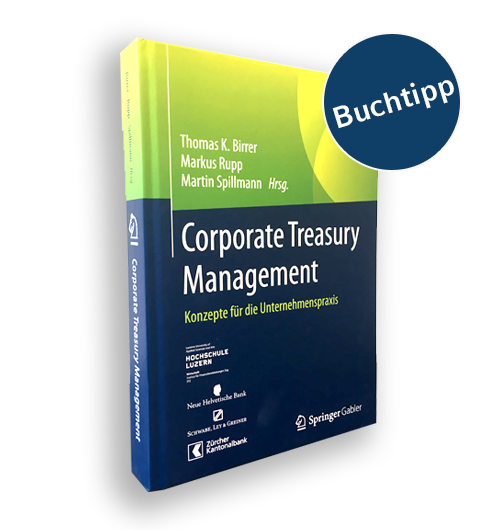Publications
Concepts for corporate practice
We are proud to have been able to contribute numerous specialist articles to this practical handbook. The aim of this publication is to address the most important challenges in the areas of cash and liquidity management, risk management, financing and technology.
This book, edited by staff of the Institute of Financial Services Zug IFZ, covers approaches to solutions for treasury organizations in the areas of cash and liquidity management, risk management, financing, and governance and operations. The authors describe how the structure of an efficient corporate treasury can be designed against the background of the changed framework conditions.
To this end, they provide the target audience of treasury managers with a picture of current trends and illustrate this with practical examples. The target group includes, in particular, application-oriented practitioners and participants in continuing education programs. The added value of the practice-oriented anthology lies in the fact that current developments are conveyed in a very practical manner and any potential for optimization of existing treasury organizations is pointed out.

Corporate Treasury Management
Concepts for corporate practice
Creditworthiness-oriented financing strategy
by Dr. Edith Leitner (SLG)
The creditworthiness of a company determines the financing options available and the (expected) financing conditions. As an expression of profitability, stability and risk-bearing capacity, creditworthiness indicates the limits of organic and inorganic growth opportunities. It enables those responsible for finance to derive a consistent target system for sustainable corporate development on the one hand and to define concrete measures for achieving the targets on the other. A "credit rating simulation" can, for example, show that the risk strategy adopted is not restrictive enough to make a substantial debt-financed investment at the same time and without jeopardizing the credit rating. In a target system of this kind, therefore, the question of maximum debt capacity - taking into account the planned development of operations - is not answered in isolation, but is linked to control approaches in risk management. This is because both debt sustainability and risk management measures have an impact on a company's probability of default. After an introduction to the topic of rating, this chapter deals with analytical instruments for determining an indicative credit rating and, subsequently, with the possible dimensions of an adequate financing strategy.
Interest rate risk management in the company
by Utz Greiner (SLG)
Interest is the price paid for the provision of capital, and this can rise and fall depending on supply and demand. Interest also always influences - directly or indirectly - the value of any asset or liability item in the company's balance sheet. In the case of interest rate instruments, such as checking or time deposits, bonds, loans and interest rate derivatives, the influence is clearer than for many other items. If interest rates determine value, then a change in interest rates determines the change in value. Consequently, we understand interest rate risk as the relationship between interest rate change and cash flow or value change. Interest rate risk management is the management of the impact of potential changes in interest rates and the cash flow or value driven by them. Corporate treasury cannot escape this issue. It must be invested or borrowed. Usually both. And either way, the outcome is uncertain - i.e., risky.
